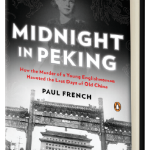ChinaMoves review: Midnight in Peking by Paul French
 Midnight in Peking- The murder that haunted the last days of old China*
Midnight in Peking- The murder that haunted the last days of old China*
A friend in China recommended this book and it was spot on. It is the true story of a British teenage girl growing up in Beijing in the thirties of the previous century. She was brutally murdered. Pamela Werner was the daughter of learned man E.T.C. Werner and a former British consul to China. The lives of her and her father have been pieced together in this vividly written ‘who dunnit’.
The reader is taken by the hand through the little alley ways (hutongs) of 1937 in Beijing, a city falling apart at the seams – half controlled by foreigners from their Legation Quarters and partly run by unscrupulous officials, corrupt policemen and swamped by refugees from the Soviet Union and a plethora of adventure seeking travelling salesmen from across the globe. It is a magnet for down-and-outs, people without a home country, villains and people with all sorts of obscure pasts and interests. It is also the base from which privileged foreigners, diplomats and officials exercise their authority over their own Legations without interference from the Chinese. In addition, and against the backdrop of the menacing Japanese who are becoming increasingly assertive day by day, one cannot but strongly sense the yoke local citizens were under without being able to flex a muscle against the miss mash of unprincipled and superior authorities. In particular, the description of the Badlands is without a doubt a stunning summary of life’s lesser noble areas. Considered a no-go area by any self-respecting or upstanding person, Chinese or other, it was controlled by drug dealers, pimps and brothel owners and teeming with activity due to the presence of small restaurants, acrobats, hawkers and the like. And yet it is home to the crime scene of a young and naive schoolgirl.
In search of her killers the book cleverly unfolds the awkward relationship between the Chinese police and British detective forces. Invisible obstacles hamper their investigations and ultimately lead to nowhere. And, as a reader you feel they aren’t getting anywhere either! One of the most shocking but perhaps less surprising eye-openers is the way in which the British Foreign Office deals with the long suffering father. He is constantly been given the cold shoulder, both in Beijing and Whitehall. When the case fails to be solved, the father decides to employ his own investigators. Through unrelenting efforts to find out who murdered his daughter – no stone is left unturned; he eventually pieces together the evidence. His findings however aren’t taken seriously, or in hindsight they probably are, as they lie at the core of a huge scandal that may never see daylight. His letters, pleading with officials to bring the alleged perpetrators to the interrogation table, simply fall on deaf ears. His study meticulously backtracks Pamela’s last whereabouts. Whilst unearthing her last steps he bumps into unseemly motives to cover up her murder. Face saving being an all-important ingredient in this gruesome tale!
The author mentions he stumbled on this story by reading Edgar Snow’s Red Star over China in which he was triggered by a footnote that “made reference to Edgar’s wife Helen feeling nervous after Pamela’s mutilated body was found not far from the Snow’s house in Peking. The footnote also mentioned……the fact that Pamela’s father had once been a British consul in China, and the murder was never solved.” He subsequently delved into the archives, spanning among others the Foreign Office, Scotland Yard, the British Library and Britain’s National Archive at Kew and reconstructed the murder case leading him to agree with E.T.C. Werner’s conclusion.
The book is definitely a must read for China lovers, travelers and business people alike. It captures the timeframe intensely. And while it is a reconstruction of a forgotten case, it reads purely like fiction. Besides being a fine read, the book also serves several other purposes. By reconstructing the murder case  Paul French has also sought to make good that which the authorities left to wither away; with this publication Pamela’s ghost can finally go to rest (the book has been dedicated to her). Her father’s efforts, although in vain during his lifetime, have also been rewarded through this work. And thirdly, but perhaps not on purpose, the book also demonstrates how mortifyingly disgraceful this era has been for the Chinese. To this day the Age of Humiliation as it is called, triggers a raw nerve in the Chinese soul. It will be interesting to learn whether a translation into Chinese may either fuel or sooth it, or similarly be read by people as a page-turner against China’s historic backdrop.
Paul French has also sought to make good that which the authorities left to wither away; with this publication Pamela’s ghost can finally go to rest (the book has been dedicated to her). Her father’s efforts, although in vain during his lifetime, have also been rewarded through this work. And thirdly, but perhaps not on purpose, the book also demonstrates how mortifyingly disgraceful this era has been for the Chinese. To this day the Age of Humiliation as it is called, triggers a raw nerve in the Chinese soul. It will be interesting to learn whether a translation into Chinese may either fuel or sooth it, or similarly be read by people as a page-turner against China’s historic backdrop.
What I would like to have had at hand was a map detailing the different Legation Quarters, towers, the location of the skating rink and the Badlands because the topography frequently refers to these sites. (Penguin USA online shows a map though!) Maybe the next reprint could include one? The photographs however lend the story an extra dimension of authenticity.
Lastly, what I really would like to know is whether any formal or informal reaction was given by the British Foreign Commonwealth Office following the revelations about its handling of this affair!
This is by no means a comprehensive review, but I think this book needs to get top marks for all the reasons above. Go out and buy your copy today!
posted by Lilian Kranenburg, ChinaMoves 5 September 2012
*First published in Great Britain by Viking, an imprint of the Penguin Books Ltd, 2011



No comments yet.